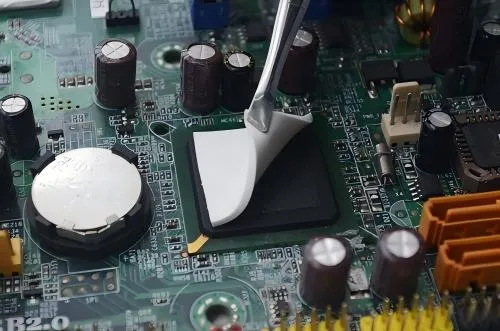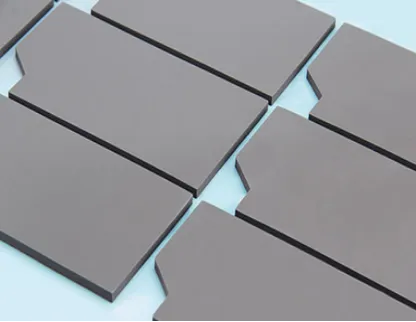Non-Silicone Thermal Pads: The Engineer’s Guide to Preventing Siloxane Contamination
Heat management is no longer just about temperature numbers — it’s about chemical cleanliness. In many high-reliability systems, Non-Silicone Thermal Pads have gone from a niche option to a design requirement because silicone-based TIMs can quietly contaminate sensitive components. Low-molecular-weight siloxanes in silicone gap fillers migrate (“bloom”) under heat and can condense on optics, poison electrical contacts, or prevent adhesives and conformal coatings from wetting properly. This article explains the science behind silicone oil migration, the standards engineers use to qualify materials (ASTM E595, FTIR, GC-MS), and why choosing non-silicone thermal pads (polyurethane, acrylic, TPE) prevents the hard-to-diagnose failures that shorten field life. You’ll get practical guidance on mechanical tradeoffs (Shore hardness, CFD), lab acceptance criteria (TML, CVCM), integration tips (lamination, dielectric film selection), and a compact decision checklist to specify and qualify non-silicone thermal pads confidently in optics, high-voltage, and automotive applications.

The Science of Silicone Oil Migration and Why It’s Dangerous
The primary challenge with traditional silicone-based thermal interface materials (TIMs) is the presence of low-molecular-weight (LMW) siloxane oligomers. These molecules are not fully cross-linked into the polymer matrix. Over time, and accelerated by thermal cycling, these oligomers "bloom" to the surface—a process known as silicone oil migration.
This migration leads to several critical failure modes:
- Silicone Poisoning: In components with moving electrical contacts, such as mechanical relays or micro-switches, migrated silicone oil can be converted into Silica (SiO2) by the heat of electrical arcing. This creates an insulating, abrasive layer that causes contact resistance to spike and leads to open-circuit failure.
- Adhesive Delamination: Silicone oil is a low-surface-energy contaminant. If oil migrates to areas where conformal coatings, potting compounds, or structural adhesives are applied, it prevents proper "wetting." This leaves the PCB vulnerable to moisture and corrosion.
- Optical Interference: In camera modules or LiDAR sensors, volatile siloxanes condense on lenses, creating a "fogging" effect that degrades signal integrity and sensor accuracy.
How Non-Silicone Thermal Pads Are Qualified
Engineers qualify materials using a combination of mass loss and chemical analysis:
ASTM E595 (Outgassing test)- Total Mass Loss (TML): Aim for < 1.0% for high-reliability optics/space applications.
- Collected Volatile Condensable Material (CVCM): Benchmark < 0.1%; best-in-class silicone-free pads often report CVCM ≤ 0.05–0.04%.
Chemical fingerprinting (FTIR / GC-MS)
- FTIR (ATR): Check for the Si–CH₃ stretch around ~1260 cm⁻¹ — absence indicates no silicone residue on the surface.
- GC-MS / Thermal Desorption: Quantifies volatile siloxanes (D4–D6). Supplier reports should include limits or non-detects.
Electrical and mechanical checks post-aging
- Dielectric strength and contact resistance before/after thermal aging.
- Compression set, compression force deflection (CFD) and adhesion after temperature/humidity stress.
Specify in RFQ: request TML, CVCM, FTIR spectra, GC-MS chromatograms (method summary), Rth at production clamp pressure, and compression set after 70°C × 72 h (example).
Mechanical & Thermal Tradeoffs: What Engineers Need to Know
- Shore hardness and conformity: Silicone pads are typically softer (Shore 00 30–50). Many non-silicone thermal pads sit at Shore 00 60–80. This higher hardness increases required assembly pressure to achieve similar bond-line thickness (BLT) and thermal performance.
- Compression Force Deflection (CFD): Calculate clamp force to meet target BLT and minimize thermal impedance (Zth). Stiffer pads require either higher clamp force or a compliant interface layer (thin TIM) to fill micro-gaps.
- Thermal conductivity: Modern non-silicone pads, heavily loaded with ceramic fillers, commonly achieve 3.0–7.0 W/m·K in typical production thicknesses.
- Reworkability: Non-silicone pads can be less tacky; some acrylic formulations have high tack and are harder to reposition — plan for precise placement jigs in assembly.
Design checklist: model BLT vs clamp torque, consider thin paste or adhesive beads under the pad for micro-gap filling, and validate assembly torque on production hardware.
Sheen Technology Silicone-Free Thermal Pad Parameter Table

| Model | AF100 | AF150 | AF300 | AF500 | AF600 | AF600G | AF800 |
| Thickness(mm) | 0.25~5.0 | 0.25~5.0 | 0.5~5.0 | 0.5~5.0 | 1.0~5.0 | 1.0~5.0 | 0.5~5.0 |
| Density(g/cm³) | 1.9 | 1.9 | 2.3 | 2.9 | 3..1 | 3.1 | 3.4 |
| Thermal Conductivity(W/m·k) | 1.0 | 1.50 | 2.0 | 3.0 | 5.0 | 6.0 | 8.0 |
| Standard Hardness(Shore00) | 50/70 | 50/70 | 50/70 | 50/70 | 50/70 | 50/70 | 50/70 |
| Elongation | 100% | 100% | 70% | 70% | 50% | 50% | 30% |
| Tensile Strength(psi) | 75 | 75 | 55 | 55 | 30 | 30 | 30 |
| Dielectric Strength(V/mil)@AC | >200 | >200 | >200 | >200 | >200 | >200 | >200 |
| Flame Retardancy Rating(UL 94) | V-0 | V-0 | V-0 | V-0 | V-0 | V-0 | V-0 |
| Volume Resistivity(Ω·cm) | 1013 | 1013 | 1013 | 1013 | 1013 | 1013 | 1013 |
| Operating Temperature(℃) | -40~125 | -40~125 | -40~125 | -40~125 | -40~125 | -40~125 | -40~125 |
| Thermal Resistance(℃*in²/W) @30psi, 1mm | 1.10 | 1.0 | 0.8 | 0.6 | 0.25 | 0.25 | 0.1 |
| Compressibility(@30psi, 1mm) | 30% | 30% | 30% | 30% | 20% | 20% | 20% |
Sheen Technology Silicone Thermal Pad Parameter Table

| Model | SF100 | SF300 | SF600 | SF700 | SF800 | SF1000 | SF1200 |
| Thickness(mm) | 0.15~10 | 0.15~10 | 0.5~10 | 0.5~5 | 0.5~5 | 0.5~5 | 0.8~5 |
| Density(g/cm³) | 2.1 | 2.3 | 3.20 | 3.40 | 3.40 | 3.40 | 3.40 |
| Thermal Conductivity(W/m·k) | 1.5 | 2.0 | 5.0 | 7.0 | 8.0 | 10.0 | 12.0 |
| Standard Hardness(Shore00) | 40/60 | 40/60 | 40/60 | 40/60 | 40/60 | 40/60 | 40/60 |
| Elongation | 50% | 50% | 30% | 20% | 15% | 15% | 15% |
| Tensile Strength(psi) | 40 | 40 | 30 | 20 | 20 | 10 | 10 |
| Dielectric Strength(V/mil)@AC | >8 | >8 | >8 | >6 | >6 | >6 | >6 |
| Flame Retardancy Rating(UL 94) | V-0 | V-0 | V-0 | V-0 | V-0 | V-0 | V-0 |
| Operating Temperature(℃) | -50~200 | -50~200 | -50~200 | -50~150 | -50~150 | -50~125 | -50~125 |
| Thermal Resistance(℃*in²/W) @30psi, 1mm | 0.9 | 0.7 | 0.31 | 0.18 | 0.15 | 0.12 | 0.10 |
When to Specify Non-Silicone Thermal Pads
Use Non-Silicone Thermal Pads when any of these apply:
- Optics / Sensors — camera modules, LiDAR, IR sensors (risk of fogging).
- High-voltage / power electronics — where insulating contamination and dielectric stability matter.
- Long-lived systems — automotive, aerospace applications with 8–15+ year lifetimes.
- Sensitive adhesive or coating steps — where downstream potting or conformal coating is planned.
For high-power small gaps, consider hybrid stacks: thin TIM or PCM at the die + non-silicone pad for bulk gap fill and electrical cleanliness.
FAQ — People Also Ask
Q: Are non-silicone thermal pads the same as silicone-free pads?
A: Yes — “non-silicone” and “silicone-free” are used interchangeably; they denote pads formulated without siloxane chemistries that can migrate.
Q: Can non-silicone pads match silicone thermal performance?
A: Modern acrylic and polyurethane pads can reach 3–7 W/m·K and, with correct BLT and clamp, deliver thermal performance comparable to silicone pads while avoiding siloxane risks.
Q: What tests prove a pad is safe for optics?
A: ASTM E595 (TML/CVCM), ATR-FTIR for Si-CH₃ peaks, and GC-MS thermal desorption for volatile siloxanes are the typical qualification set.
Q: Do non-silicone pads require special assembly tools?
A: Not usually, but some high-tack acrylic pads are less repositionable; using placement jigs and controlled torque fixtures is recommended.
Q: Is "Low-Bleed" silicone the same as Silicone-Free?
A: No. "Low-bleed" materials are still silicone-based and contain siloxanes. They are an improvement for consumer electronics but do not eliminate the risk for ultra-sensitive optics. Truly non-silicone thermal pads (PU or Acrylic) are the only 100% risk-free choice.
Q: Can Non-Silicone Thermal Pads melt during operation?
A: Most non-silicone pads are thermoset materials. They do not melt into a liquid; rather, they remain stable until they reach their degradation temperature. This prevents the "leakage" often associated with lower-quality greases.
As power density and sensor sensitivity rise, chemical compatibility becomes as crucial as thermal conductivity. Non-Silicone Thermal Pads eliminate a major root cause of field failures — siloxane migration — while offering competitive thermal performance when properly specified and assembled. For optics, high-voltage systems, and long-lived products, they should be the default choice.
Ensure your sensors stay clear and your contacts stay conductive. Contact Sheen Thermal today to request ASTM E595 test reports or to receive a sample kit of our high-performance silicone-free materials.

 English
English
 usheenthermal
usheenthermal



